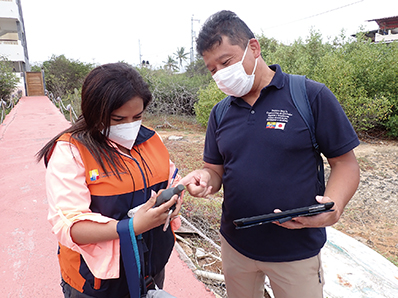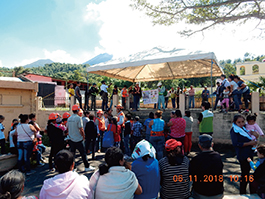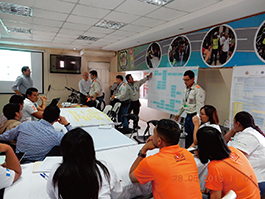(7) Mainstreaming of Disaster Risk Reduction, Measures of Disaster Risk Reduction, and Post-Disaster Recovery and Creating Sustainable Cities
In developing countries that are vulnerable to disasters, disasters have a significant impact on the entire society and economy. Therefore, it is necessary to build a disaster-resilient and flexible society to protect human lives from disasters. At the same time, efforts toward sustainable development are needed. Among them, it is important to promote the “mainstreaming of disaster risk reduction” that introduces the perspective of disaster risk reduction in all the development policies and plans.
Moreover, in recent years, various issues related to the management of cities are receiving increased attention. For example, such issues as handling the disposal of the substantial amount of waste emitted in urban areas and suburbs, air, water, and other pollution, development of infrastructure facilities including sewage and waste treatment systems, and rapid population increases and the consequent rapid pace of urbanization. Addressing these issues and engaging in efforts to realize sustainable cities have become priorities for development cooperation.
Thus, among the SDGs, Goal 11 sets forth the following task: “Make cities and human settlements inclusive, safe, resilient and sustainable.” Likewise, there are growing international interests in resolving the issues of human settlements that include realizing sustainable cities.
● Japan’s Efforts
■ Cooperation in Disaster Risk Reduction

A Japanese expert providing instruction during a workshop for the socialization of the manual for the preparation of the tsunami evacuation Plan in Ecuador (Photo: JICA)
Japan utilizes its enriched knowledge and technology acquired through its past experiences with natural disasters, such as earthquakes and typhoons, to provide proactive support for disaster risk reduction and post-disaster recovery measures, alongside emergency assistance (see “Stories from the Field 3,” and “Project Introduction Columns” on Guatemala, Bangladesh, and Chile). The Sendai Framework for Disaster Risk Reduction 2015-2030 (Sendai Framework), which was adopted at the Third UN World Conference on Disaster Risk Reduction (2015), incorporated many ideas proposed by Japan, such as the “mainstreaming of disaster risk reduction,” the importance of prior investment in disaster risk reduction, the commitments of diverse stakeholders, the concept of “Build Back Better” striving to build cities that are more resilient to natural disasters after disasters, and the importance of women’s leadership.
Currently, based on the Sendai Cooperation Initiative for Disaster Risk Reduction Phase 2 announced in 2019, which is Japan’s basic policy for cooperation in the field of disaster risk reduction, Japan contributes to the development of a disaster-resilient international community where everyone can live in safety by utilizing its advanced expertise and technology in the field of disaster risk reduction. Specifically, Japan has promoted human resources development for a total of 48,000 officials and local leaders and disaster risk reduction education for a total of 37,000 children who are responsible for the next generation, in addition to the support provided for at least five million people over the four-year period from 2019 to 2022 through flood countermeasures and other measures. Such efforts contribute to promoting not only the maintenance of disaster-resilient building structures and upgrading disaster monitoring facilities in each country, but also the development of human resources in fields such as laws and plans enactment related to disaster risk reduction, formulation of disaster risk reduction policies, and disaster monitoring. Consequently, the mainstreaming of disaster risk reduction is progressing in developing countries.
In addition, a resolution was adopted to designate November 5 as World Tsunami Awareness Day responding to Japan’s encouragement at the UN General Assembly in 2015. Accordingly, the “High School Students Summit on World Tsunami Awareness Day” has been held throughout Japan since 2016, and on November 5, 2021, Japan co-organized an event to raise awareness of the necessity to reduce the risk of tsunamis at the UN Headquarters with the United Nations Office for Disaster Risk Reduction (UNDRR).
Moreover, in close cooperation with UNDP, Japan has implemented projects to support the formulation of tsunami evacuation plans and tsunami evacuation drills for countries at high tsunami risk in the Asia-Pacific region. Under these projects, Note 69 during the period from December 2018 to February 2021, in Palau, a Presidential Proclamation was implemented declaring September of every year as National Preparedness Month, and the institutionalization of disaster risk reduction has been promoted. Also, during the same period, teacher and other staff training were conducted, and the formulation and revision of tsunami disaster management plans as well as programs for tsunami education were implemented at 265 schools across 15 countries, with 100,119 students, teachers, and other school personnel participating in tsunami evacuation drills. In addition, in 2021, Japan implemented technical assistance through UNDRR to Arab countries (Egypt, Jordan, and Lebanon) to formulate disaster risk reduction strategies for “Build Back Better,” taking into account measures to address infectious diseases such as COVID-19.
Additionally, every year since 2016, Japan and the United Nations Institute for Training and Research (UNITAR) Hiroshima Office have worked together to provide support for human resources development related to women’s roles and leadership, particularly in the event of tsunamis, targeting female government officials and others in developing countries vulnerable to natural disasters. Under this project, 287 people from 26 Pacific and Indian Ocean island countries have participated by the end of 2021.
Japan also contributes in the field of overseas deployment of ICT for disaster risk reduction. Japan’s ICT for disaster risk reduction makes it possible to collect, analyze, and distribute disaster information in an integrated manner, allowing detailed information to be communicated swiftly and infallibly at the community level. This contributes to the improvement of disaster risk reduction capabilities in developing countries.
■ Realizing Sustainable Cities
Japan implements initiatives to resolve global issues directly related to human settlements, including efforts for promoting disaster risk reduction, recovery from natural disasters, and a sound water cycle. In particular, drawing on its know-how and experience, Japan develops infrastructure, including water and sewage, waste, and energy facilities. In addition, Japan conducts disaster risk reduction programs, human resources development, etc. based on the concept of “Build Back Better” (see also “Stories from the Field 3” and “Stories from the Field 5”). Japan works together with the United Nations Human Settlements Programme (UN-Habitat) to further promote sustainable urban development. One example can be seen in collaboration with the UN-Habitat Regional Office for Asia and the Pacific (ROAP) in Fukuoka, which supports the introduction of the disaster prevention technology of Fukuoka prefecture to developing countries.
Guatemala
Project on Capacity Development for Disaster Risk Management in Central America “BOSAI” Phase 2
Technical Cooperation Project (July 2015 – June 2020)
As with Japan, the Central America region faces risks from a variety of natural disasters, including earthquakes, volcanic disasters, and storm and flood damage. Japan has been providing a variety of assistance for disaster risk reduction to this region, utilizing its own knowledge and experience. The Project on Capacity Development for Disaster Risk Management in Central America (BOSAI) started in 2007, targeting six Central American countries,*1 and has steadily advanced initiatives that were implementable at the community level, such as building dikes utilizing used tires. In 2015, Phase 2 of the project commenced with the aim of expanding such outcomes in each country and across the Central America region.
In Guatemala, one of the target countries of Phase 2, actions were taken to strengthen the volcanic disaster prevention capacity of the National Coordinator for Disaster Reduction. Through the project, a volcanic disaster risk prevention council was established for each volcano, enabling members of institutions involved in disaster risk reduction and volcano observation as well as officials of the departmental and city governments to come together to advance countermeasures. Volcanic disaster risk reduction maps were also updated with a system that enables all necessary information to be obtained at once during a disaster. Initiatives have been implemented, including development of a system for the residents in the vicinity of a volcano to utilize radio and social media to report to officials in charge of disaster risk reduction about a volcano’s condition, and utilization of the record of the experiences from past disasters, learned from interviews with residents, as teaching materials. As a result, awareness of disaster risk reduction of the residents has gradually improved.
When the volcano Fuego erupted in 2018, concrete results of these efforts were seen. For example, the residents who had received the training recognized the danger, encouraged the evacuation of their neighbors and practiced the emergency first-aid that they had learned in the training. Subsequently, the project itself was also modified based on the lessons learned from the problems of equipment and infrastructure used for observation and evacuation warning, which were revealed in the incident of eruption.
Even after the completion of the project, the residents of Guatemala themselves have continued disaster risk reduction initiatives that utilize the knowledge and experience of Japan, such as training for efficient management of evacuation centers.

A Japanese expert team explaining to the residents about volcanic disaster risk reduction maps (Photo: JICA)

Staff of the National Coordinator for Disaster Reduction preparing the timeline in consultation with municipal officers and Japanese experts (Photo: JICA)
*1 Guatemala, Honduras, El Salvador, Costa Rica, Panama, and Nicaragua (Nicaragua was included from December 2008).
- Note 69: Phase II of the projects targeted 18 countries in the Asia-Pacific region (five of which are newly added).
